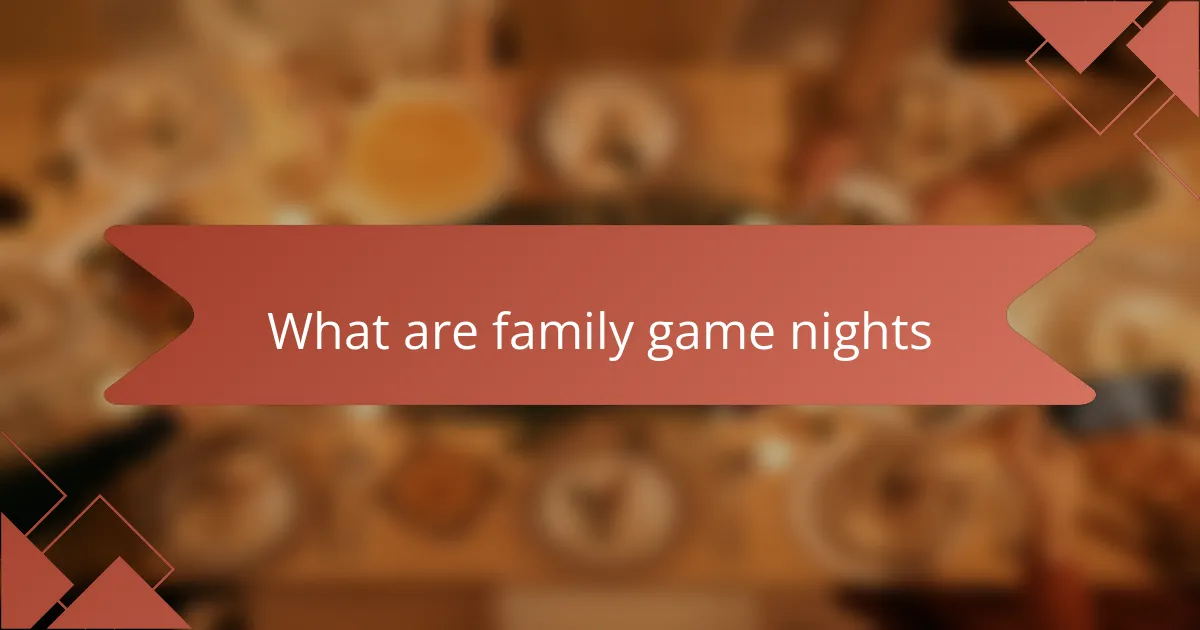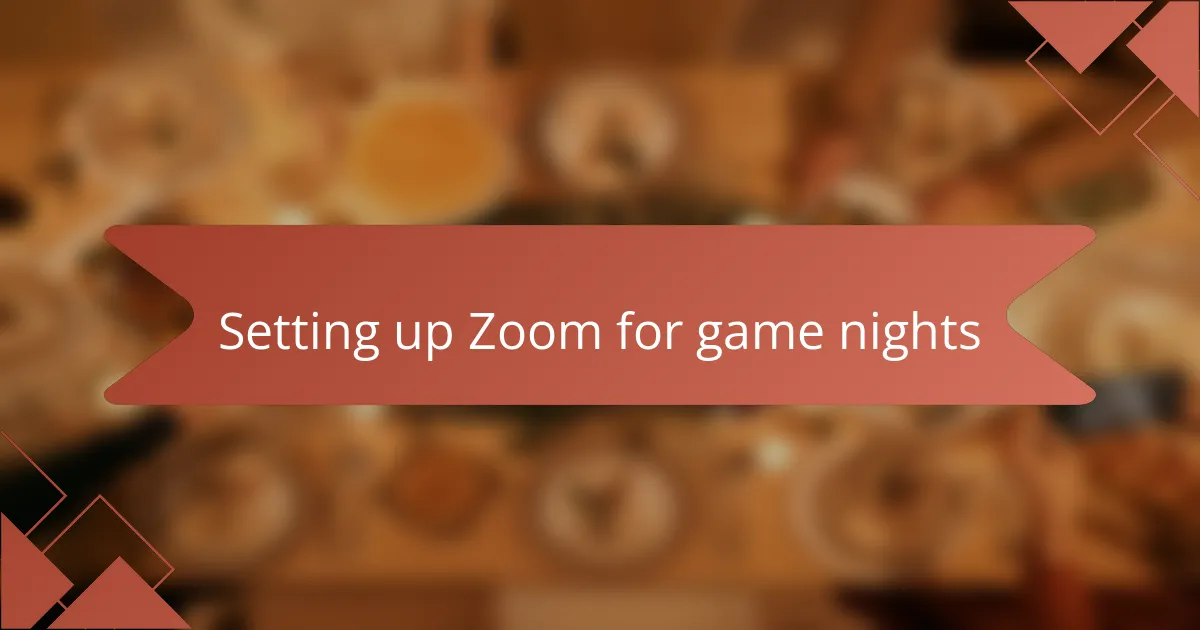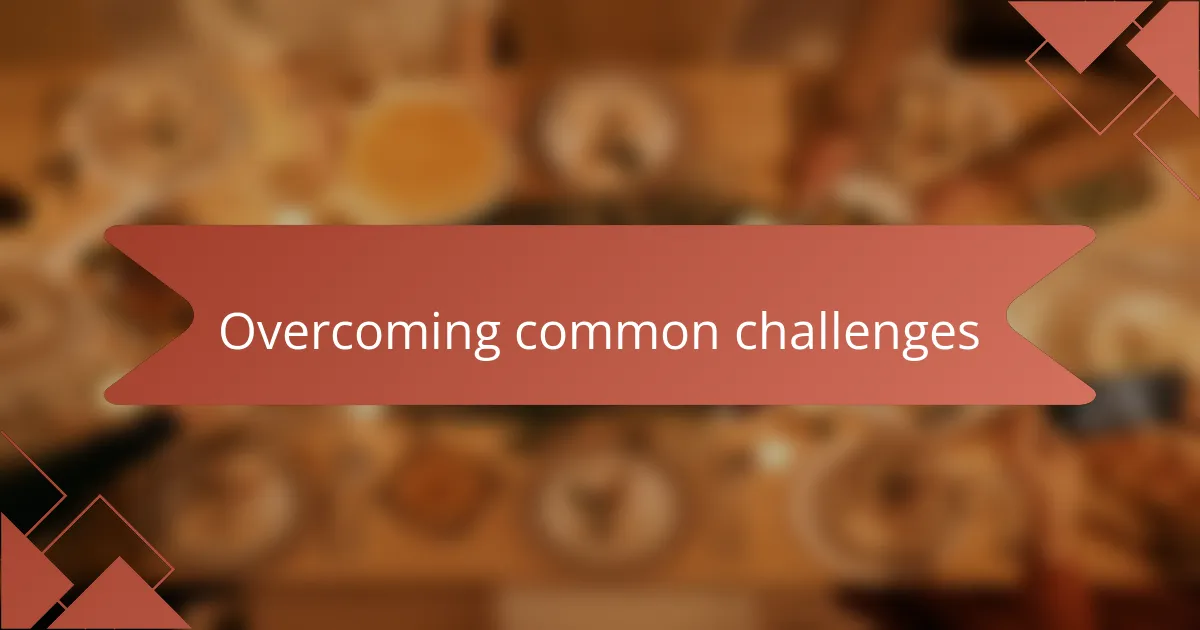Key takeaways
- Family game nights foster connection, laughter, and cherished memories, whether in-person or virtual.
- Choosing simple, interactive games and engaging all family members enhances participation and enjoyment during virtual gatherings.
- Effective use of Zoom features, such as screen sharing and breakout rooms, improves the gaming experience and keeps everyone involved.
- Patience, flexibility, and encouraging personal game suggestions can transform technical challenges into bonding moments.

What are family game nights
Family game nights are those special evenings when everyone sets aside their usual distractions to come together and play games. It’s more than just rolling dice or moving pieces on a board; it’s about sharing laughter, friendly competition, and creating memories. Have you ever noticed how a simple card game can turn into a treasured tradition?

Benefits of virtual game nights
One of the benefits I quickly noticed with virtual game nights on Zoom was how effortlessly everyone could join in, no matter where they lived. It felt amazing to laugh and compete with my cousins who are miles away, something that wouldn’t happen as often otherwise. Have you ever experienced that surprise moment when a family member bursts into laughter across the screen, making you forget the distance?
Another thing I appreciated was how virtual game nights kept everyone connected during busy or unpredictable times. Even when schedules didn’t match up perfectly, a quick Zoom call let us share those fun moments without the hassle of travel. It reminded me that sometimes the best memories come from just showing up—even if it’s through a screen.
Finally, virtual game nights brought a new layer of excitement to our family traditions by mixing technology with our favorite old games. Seeing everyone’s faces light up through the camera added warmth and closeness that felt surprisingly real. Doesn’t it make you wonder how adapting to new ways can deepen connections rather than replace them?

Choosing the right games for Zoom
Choosing the right games for Zoom wasn’t as simple as picking our usual favorites. I quickly learned that games needed to be easy to explain and play without physical pieces, since no one could reach across the table. Have you ever tried to coordinate a complicated board game over pixelated video and realized it just doesn’t flow the same way?
I found that games focusing on words, quick thinking, or simple visuals worked best. For instance, trivia or charades gave everyone a chance to jump in without feeling lost. It was fascinating to see how a game designed for in-person fun could be reinvented with just a little creativity—and suddenly, even my shy cousins were laughing and competing with full enthusiasm.
Another thing I noticed was how important pacing became. Zoom calls have their own rhythm, and games that dragged on felt clunky and made people check out. What helped me keep energy high was picking short rounds and mixing in spontaneous games that anyone could suggest—and that way, everyone stayed engaged and looked forward to the next family night.

Setting up Zoom for game nights
Setting up Zoom for game nights was surprisingly straightforward, but I quickly realized a few tweaks made all the difference. For example, I made sure everyone had the latest Zoom update to avoid glitches mid-game—because nothing kills excitement faster than frozen screens or lost connections. Have you ever felt that moment of panic when your video freezes right as you’re about to reveal a winning move?
I also took the time to explore Zoom’s features like screen sharing and breakout rooms. Sharing my screen to display scoreboards or game prompts helped keep everyone on the same page and made the experience feel more interactive. And breakout rooms became a lifesaver when splitting into smaller teams—it’s amazing how a simple click can recreate that cozy, side-by-side feeling.
One unexpected discovery was how crucial good lighting and sound are. I encouraged my family to find a quiet, well-lit spot, which made a huge difference in reading [censured] expressions and picking up on the subtle cues that games often depend on. Don’t you find that without those little details, it’s easy to miss out on the full fun? Setting these up felt like laying the foundation for a night full of laughter and connection.

Tips for engaging family members
Keeping everyone engaged on Zoom can be tricky, but I found that involving family members in choosing the games really helped. When people pick what they want to play, their excitement becomes contagious—it’s like they’re already halfway in before the game even starts. Have you ever noticed how enthusiasm spreads when someone’s favorite game comes up?
I also discovered that calling on quieter family members by name makes a big difference. Sometimes a gentle prompt, like “Hey, what do you think about this?” draws them out and makes them feel included. It reminded me how important it is not to let anyone slip into the background, especially when screens can make us feel distant.
Timing each game with breaks was another key lesson. Zoom fatigue is real, and when I planned short, lively rounds with casual chat pauses, energy stayed high. Isn’t it amazing how a simple break to share a funny story or quick check-in can re-energize the whole group? That little rhythm made our game nights feel less like a meeting and more like hanging out.

Overcoming common challenges
One challenge I faced early on was the occasional technical hiccup—frozen screens, lagging audio, or family members struggling to connect. I found that patiently walking everyone through basic troubleshooting and having a backup plan, like a phone call for audio, kept the mood light. Have you ever felt that mix of frustration and amusement when your uncle’s video freezes mid-laugh?
Another hurdle was managing different time zones and busy schedules. It took some trial and error, but finding a regular time slot that worked for most and sending friendly reminders made a huge difference. It was rewarding to see how even the busiest cousins made an effort because the connection felt meaningful.
Sometimes, I noticed that keeping everyone engaged through a screen wasn’t as easy as in person. I learned to mix up game types, encourage participation from quieter relatives, and sprinkle in funny stories to keep the energy up. Doesn’t it surprise you how a simple “Hey, your turn!” can pull someone out of their shell and bring fresh fun to the group?

Personal success stories and advice
One night, as we wrapped up a particularly chaotic round of Zoom charades, I caught my teenage niece beaming with pure joy despite the miles between us. It struck me then how these virtual game nights didn’t just fill the screen with laughter but also bridged gaps in ways I hadn’t expected. Have you ever had a moment when technology suddenly felt less like a barrier and more like a warm embrace from afar?
From my experience, patience and flexibility became my secret weapons. When a game stalled because someone’s connection faltered, instead of frustration, I learned to lean into light-hearted banter or quick mini-games that needed no setup. This shift turned potential hiccups into bonding moments, making everyone feel relaxed and included rather than embarrassed or left out.
Encouraging family members to suggest games made a surprising difference too. It wasn’t just about variety—seeing a shy cousin light up when their favorite word game came on reminded me how empowerment fuels engagement. Isn’t it fascinating how giving people a voice can transform a tentative “hello” into a night filled with genuine smiles and shared stories?